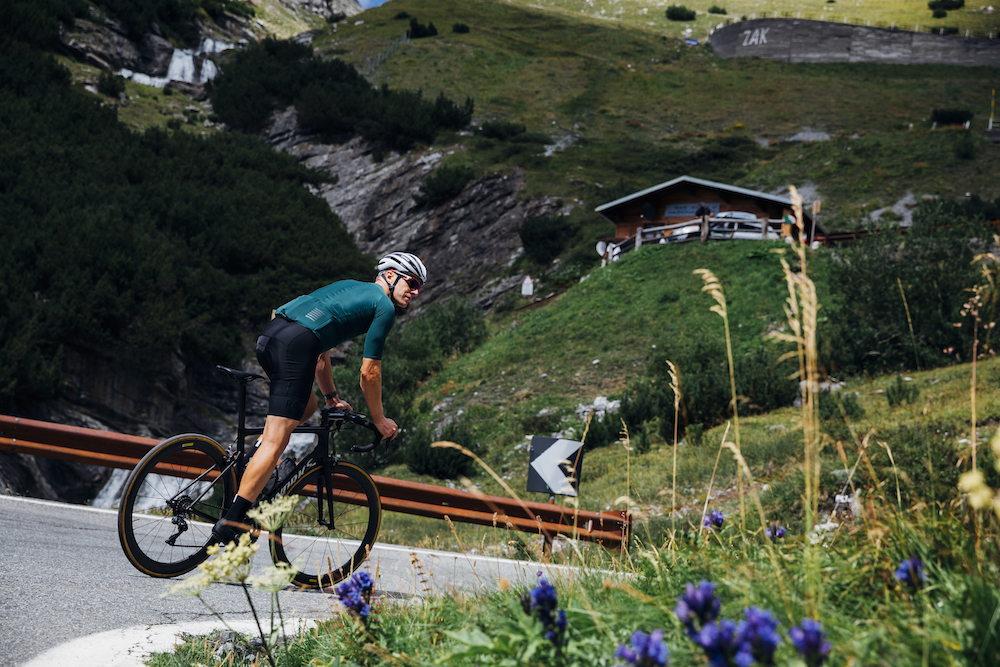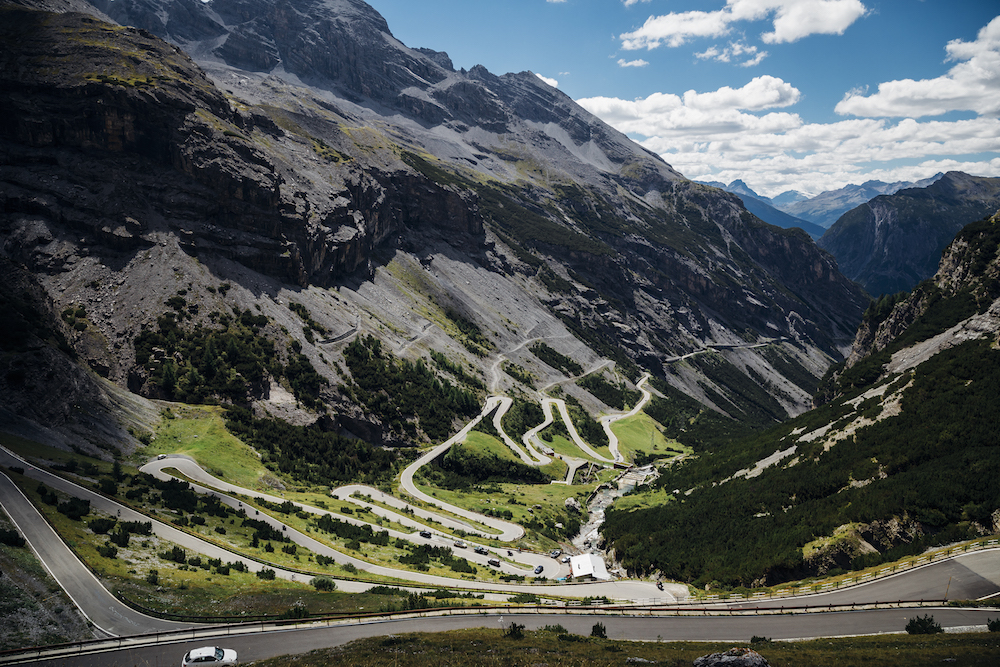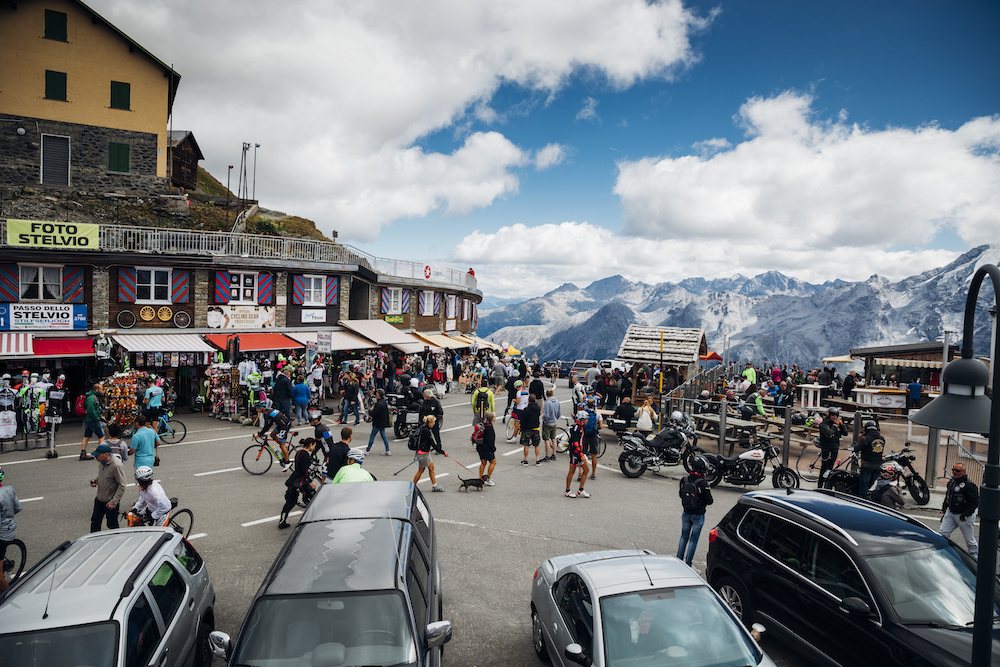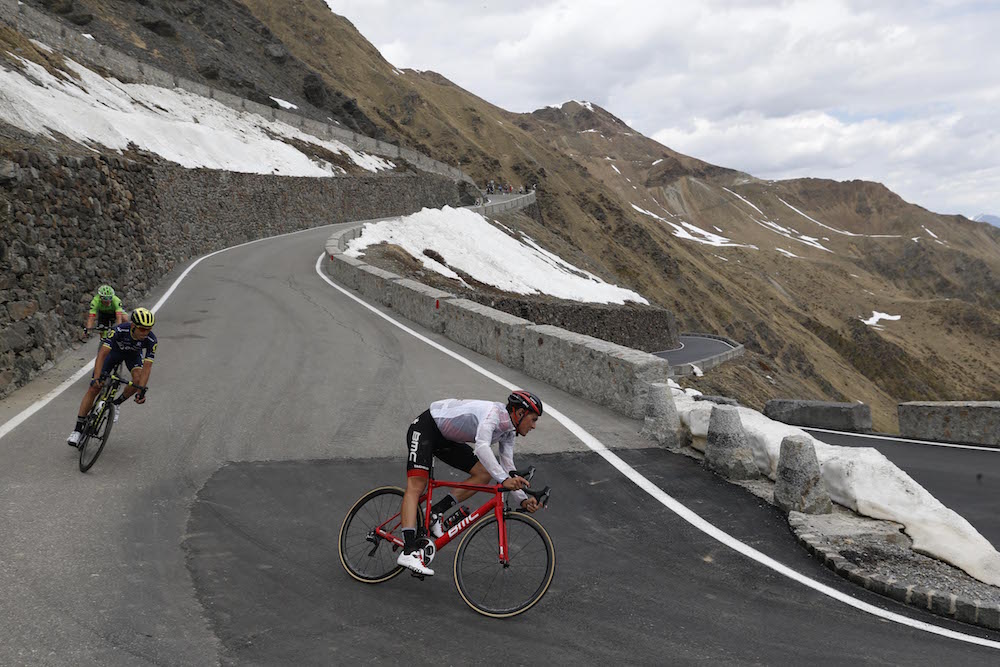Riding to the sky above: Taking on the Passo dello Stelvio
The highest summit finish in Grand Tour history... Paul Knott headed to the Passo dello Stelvio to tick this bona fide bucket-list climb off his list

It was almost as if the cycling gods were aware of what was to come. A thunderstorm greeted us upon landing at Milan Malpensa airport before we made our way north towards the Alps on flooded roads; our final destination a stretch of road famous for pushing the minds and bodies of cyclists to the limit, the Passo dello Stelvio.
Sketchy weather isn’t anything new to the Stelvio Pass, which has seen many an epic Giro d’Italia stage played out to the backdrop of snowstorms and unrelenting rain. Nairo Quintana infamously attacked, on a supposedly neutralised Stelvio descent, to take the pink jersey in 2014 and go on to win the race altogether.
But even the hardy pro peloton has seen stages cancelled due to the inclement conditions, so I went to sleep that night fearing the trip may be a non-starter. However, any prospect of postponing our ascent was swiftly forgotten as we woke the following morning to blue skies and a gentle breeze.
Pursuit of pleasure... or pain
Rolling out from our apartment in Valdisotto, a small town south of Bormio, I form a mini team time trial with CW colleagues Richard and Dan. Personally I can tell I am feeling the weakest out of our trio and the thought of two hours of hard riding solo wasn’t what the doctor ordered.

The Stelvio has a long list of accolades attached to it, in part down to its height at 2,758m — the second highest paved climb in the Alps behind the Col de l’Iseran. It is also the highest stage finish of any Grand Tour to date, playing that role four times in the Giro ’s history. But I wasn’t feeling like my ascent was about to create any such historic landmarks.
As we begin to climb out of Bormio, we are greeted with three distinctive signs of what lies ahead. Firstly a wall with brickwork signalling you are leaving Bormio at 1,225m — any previous research of the Stelvio will tell you that there is about 1,500 metres of climbing to the top. Next to it is a bright pink shark tooth race profile of the 2017 Giro d’Italia stage, where the peloton ascended the Mortirolo, the Stelvio from the Bormio side before heading back up the Umbrail Pass and down the fast and flowing finish into Bormio. Lastly, there’s the infamous first hairpin sign — there are 40 turns or tornantes that can be agonisingly counted down to the summit.
The latest race content, interviews, features, reviews and expert buying guides, direct to your inbox!

Then there was one
We leave the north of Bormio on the Via Stelvio on what the Italian road network calls the SS38. If you believe these countdown signs might make for nice motivational checkpoints to tick off, think again — after number 37 the long straight lines of asphalt eliminate the sight of the signs for the first third of the climb.
By this point my fears have been realised and my ride companions have shown no mercy, upping the pace enough to snap the elastic and form a 20-metre gap. I know trying to latch on will more than likely pay when altitude and fatigue kicks in further towards the summit. Despite maintaining this gap for a couple of kilometres, soon enough this grows until they are out of sight on the shallow corners. See you at the summit, friends!
The Stelvio is known for its hairpins and the postcard shot of the switchbacks is arguably the most iconic in cycling. However, the long drag up to the first set of switchbacks is mentally the toughest part of the climb. You are dwarfed by stunning mountains in every direction as the road rises towards a destination that appears non-existent at this early stage.

The skidmarks that greet you at turn 36 showcase the popularity of the climb not only with cyclists, but with cars as well. In comparison to many other cycling Meccas that tend to be enjoyed exclusively by bicycle riders, the Stelvio doesn’t offer the same experience. Partly in thanks to Top Gear once claiming the road to the top of the Alp was the ‘greatest driving road in the world’, it sports a constant flow of motorbikes and cars making a pilgrimage to the summit.
Luckily the wide roads are kept in good condition, especially compared to other climbs in the area. However, if a quiet ride is more of an attractive proposition, then heading up early or late in the day is probably your best bet. Or if you want to be sure to ride the climb without any motor vehicles, the Stelvio National Park closes off all three ascents to the top to motorised traffic on the last Saturday in August or first Saturday in September.
Bormio side — western ascent
Distance: 20.8km
Elevation gain: 1,505 m
Average gradient: 7.2 %
Min elevation: 1,219m
Max elevation: 2,758m
Umbrail Pass from Santa Maria — western ascent
Distance: 16.4km
Elevation gain: 1,358m
Average gradient: 8.1 %
Min elevation: 1,400 m
Max elevation: 2,758 m
Prato side — eastern ascent
Distance: 24km
Elevation gain: 1,827 m
Average grade: 7.6 %
Min elevation: 931m
Max elevation: 2,758m
Tunnel vision
Despite the turn checkpoints not coming as frequently as I’d like, the first major section of the climb has six tunnels hugging the right side of the Braulio valley that are useful markers.
The first one of these is around eight kilometres into the climb (a mini tunnel which is more like a gateway greets you earlier in the climb), before the next five follow in quick succession. All of these are quite well lit, though you may want lights for extra safety in low light. Be wary that one of these tunnels is subject to traffic lights as well, which comes as a welcome respite for some and an unnecessary rhythm breaker for others. For anyone looking to rack up a clean GPS signal from bottom to top, it is unlikely your bike computer will agree as these tunnels skew the signal.
Just before the entrance to the final tunnel I glimpse a shoelace-like road winding its way up the mountain in the distance, and my fading morale from riding 10 kilometres without the sight of the true Stelvio is reinvigorated as the first of the iconic switchbacks comes into view.

My joy is short-lived as the steepest drag of the climb sneaks up on me as the straight road ramps up to 13 per cent. With the ramp conquered, my confidence begins to rise as I tick off each hairpin and inch my way above the imposing valley.
Resisting the temptation to grab a shot of the picture-perfect view, the climb straightens out once again and a lull in gradient allows me to shift through the gears and up the pace a fraction. Having only been overtaken by one other rider other than my two compatriots, and slowly picked off many others on the way, I’m beginning to feel pretty good about myself.
That is until a flash of Bora-Hansgrohe jersey flies past — which I later ascertain was Rafał Majka fine-tuning his form ahead of his 13th-place finish at the Vuelta a España the following month. As the Polish rider disappears up into the clouds, I set about finding my rhythm, and my place in cycling’s hierarchy, as the road ramps up to a consistent eight per cent once again.
So close, yet so far
As I reach the turn off-for the Umbrail Pass at just over 2,500m, the summit of the Stelvio comes into the clearest of views with the collection of hotels, cafes and the traffic that has passed me all nestled at the crown of this majestic mountain. It seems so close, but so far when you consider the effects of altitude at heights like this and the effort already in my legs. It’s almost as if the climb itself knows you are that close and adds in another factor you have to fight, as for the first time on what has been a pleasantly warm day the temperature begins to noticeably drop.
The relief of seeing the top for the first time was at least a reprieve after 100 minutes or so of slogging up the climb. The vast length but manageable gradient of the Stelvio is distinct in comparison to some Italian monsters like the Zoncolan and Mortirolo, which have far less forgiving inclines over shorter distances.

The Stelvio is over 20 kilometres from whichever side you conquer it, which will equate to most amateur riders spending at least an hour and a half in the saddle. I’m edging closer to the two-hour mark as the final tornantes count down, with photographers on the bends catching the final moments of pain and glory before the sweet relief of the summit.
As I attempt to look calm and collected as the cameraman snaps away, my legs and lungs are telling me something different, though my metronomic, if ever slowing, rhythm begins to kick in once out of sight of the lens.
The final grind to the top shifts from hairpin bends and long stretches of asphalt, to steeper pitches and sweeping bends. Just before tornante one arrives, a ‘Passo dello Stelvio’ road sign that isn’t covered in thousands of stickers from cycling clubs and motorcycle gangs across the world represents the prime opportunity for a photo. I pass and push on to the top, which is — as expected— a mountain-top version of Piccadilly Circus.

As I arrive around midday the place is littered with knackered cyclists, chirpy motorcyclists and a cluster of cars, their passengers taking snaps of
the vistas either side. I’m just craving some sustenance that doesn’t come out of a gel wrapper and will refuel my mind more than anything for the lightning fast descent.
Looking down at the constant flow of people, and reflecting on the past two hours weaving my way through the giant mountains that loom over me, I realise just how big and how small you can feel once you conquer one of the grandest mountains in all of cycling.
Stelvio and the Giro

The three Grand Tours each have a claim to certain climbs that define their races: the Angliru at the Vuelta; take your pick from Alpe d’Huez, the Tourmalet or Galibier at the Tour de France. But the Stelvio stands alone as an icon of the Giro d’Italia — partly because of its presence in the race since 1953, but also its stature as the Cima Coppi par excellence, the highest point ever reached in the Giro.
The Cima Coppi was first introduced in 1965, the first time the Alp had a summit finish on stage 20 from Madesimo, with eight further appearances in the race including three additional summit finishes in the 1972, 1975 and 2012 editions. The Stelvio was also set to feature in the 1965, 1988, and 2013 races, but was removed late on due to weather conditions.
The three roads up the Stelvio make it one of the most versatile climbs in cycling, surrounded by potential finish towns as well as having the infrastructure for a summit finish itself — the last of which was Thomas De Gendt’s memorable attack to win stage 20 in 2012. The Stelvio is a climb that will remain at the heart of the Italian Grand Tour for a long time to come.
Stelvio travel guide
How to get there
The nearest major city is Milan, with both Malpensa and Linate airports serving flights direct from the UK. However a 3.5-hour drive is then needed to
get to Bormio.
Where to stay
Bormio is a hub for cycling in the area with not only the Stelvio in striking distance, but also well-known climbs such as the Gavia and Mortirolo near by.
Bike shops
There are two shops in Bormio, the small but well-equipped Spot-On Bike Shop and Bormio Ski & Bike Rental. If you want to hire a bike, make sure you pre-book in busy periods.
Cafe stop
If it’s not too cold at the summit, you’ll be gagging for sustenance after a gruelling ascent. Cafe Perego delivers on tasty pizzas, coffees and soft drinks to refuel your body and mind for a rapid descent.
When to go
Due to its location and altitude, the Stelvio is pretty much off limits from late September to early May. The peak of summer may well be the hottest. The chances are snow won’t be blocking your path, although it did fall the week after CW visited in mid-August!
Paul Knott is a fitness and features writer, who has also presented Cycling Weekly videos as well as contributing to the print magazine as well as online articles. In 2020 he published his first book, The Official Tour de France Road Cycling Training Guide (Welbeck), a guide designed to help readers improve their cycling performance via cherrypicking from the strategies adopted by the pros.